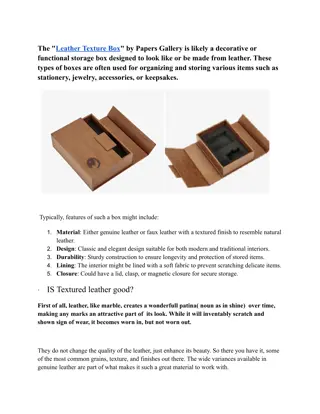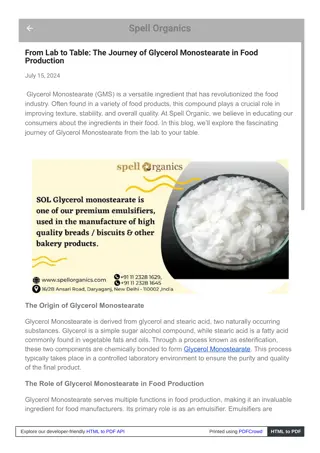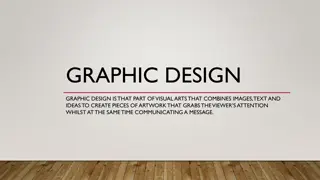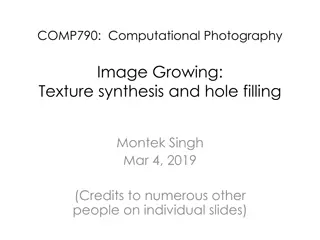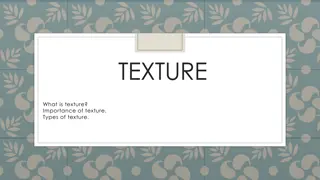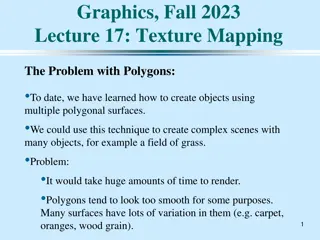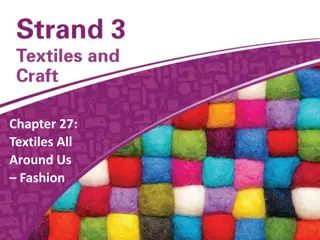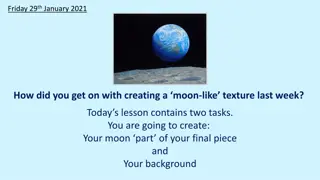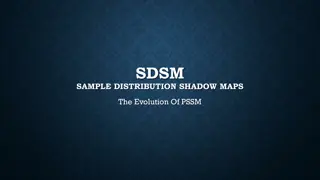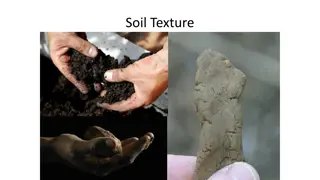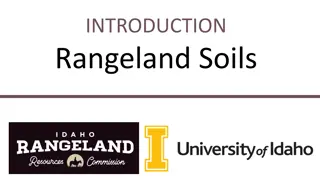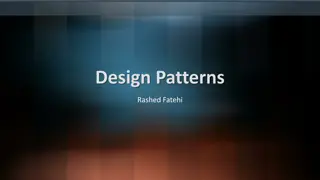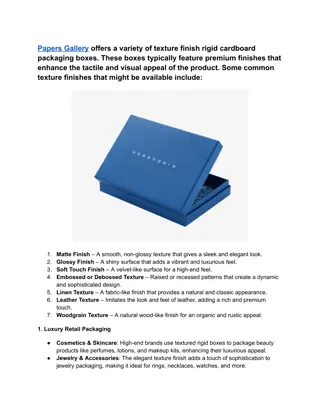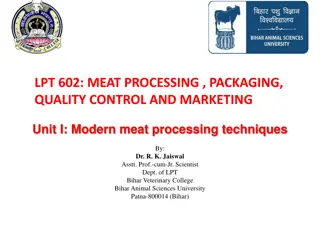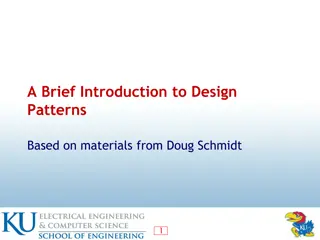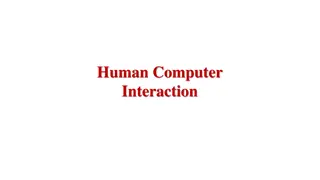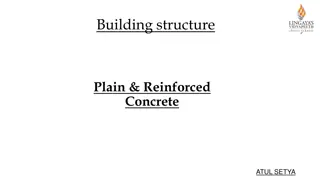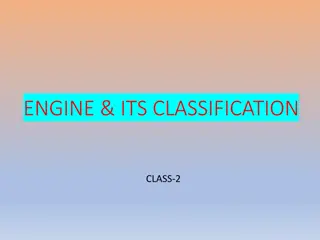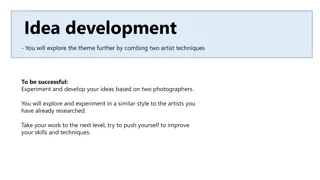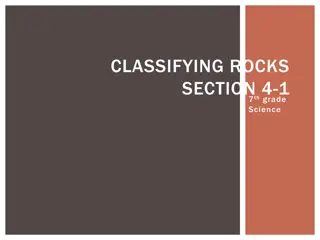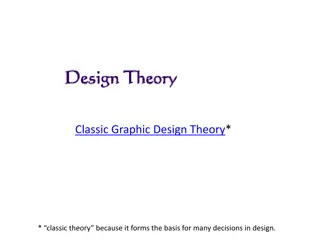Premium Leather Texture Box
The \"Leather Texture Box\" by Papers Gallery is likely a decorative or functional storage box designed to look like or be made from leather. These types of boxes are often used for organizing and storing various items such as stationery, jewelry, ac
1 views • 2 slides
Modern Techniques in Apparel Designing and Pattern Development by Mrs. Sonia Khanna
Mrs. Sonia Khanna, an Associate Professor in Home Science, discusses the art of apparel designing and modern pattern development techniques, emphasizing the importance of elements and principles of design in creating garments. The content covers aspects such as structure, functionality, and decorati
0 views • 41 slides
Enhancing Texture and Extending Shelf Life in Baking with Glycerol Monostearate
Glycerol Monostearate (GMS) is a versatile ingredient in baking, known for enhancing texture and extending shelf life. By acting as an emulsifier, Glycerol Monostearate (GMS) helps to improve the consistency and stability of dough and batter, resulti
1 views • 3 slides
Sediment and Sedimentary Rock Textures
Discover the textures and structures of sediment and sedimentary rocks, including clastic and crystalline textures, primary and secondary textures, and the effects of compaction. Learn about sediment texture, differences in sedimentary rock texture, and the classification of grain sizes using the We
1 views • 20 slides
Graphic Design Elements and Principles
Graphic design is a crucial part of visual arts that combines images, text, and ideas to create captivating artwork while effectively communicating messages. Explore the seven basic elements of graphic design including line, shape, color, texture, type, space, and image, each playing a vital role in
2 views • 12 slides
Guidelines for Design of Cement Concrete Pavement and Interlocking Paver Blocks
This document provides guidelines for designing cement concrete pavements and interlocking paver blocks, covering factors governing design, wheel loads, design period, subgrade characteristics, approximate k values based on CBR values, and the importance of a sub-base below concrete pavements. It em
0 views • 67 slides
Principles and Elements of Interior Design Explained
Explore the fundamental principles of interior design, including proportion, rhythm, emphasis, balance, scale, and harmony. Delve into the significance of scale, proportion, rhythm, emphasis, balance, and harmony in creating cohesive and visually appealing spaces. Discover how design elements like s
0 views • 18 slides
Computational Photography: Texture Synthesis and Hole-Filling Overview
Delve into the world of texture synthesis and hole-filling in computational photography, exploring the challenges, goals, and techniques involved in creating new textures and filling in image gaps. Learn about building probability distributions, modeling textures, and the intricacies of synthesizing
0 views • 52 slides
Software Engineering Design Principles and Concepts
The chapter discusses the essential principles and concepts in software design, highlighting the four key design models - data design, architectural design, interface design, and component-level design. It emphasizes the importance of traceability to the analysis model, minimizing the gap between so
2 views • 36 slides
Texture in Design: Types and Importance
Texture plays a crucial role in design by adding visual interest, contrast, and balance to compositions. There are two main types of texture: Image texture, which includes environmental, biological, and man-made textures, and Pattern texture, which is structured and often used for decoration or bran
0 views • 12 slides
Song Structure and Arrangement in Music Education
Delve into the intricacies of song structure and arrangement with this resource pack designed for Year 7 and 8 music students. From defining song concepts to experimenting with musical texture, harmonic ideas, and more, students will learn to lay the foundations for creating captivating songs. Engag
0 views • 12 slides
Science of Cooking: Heat Transfer, Changes, and Methods
Explore the reasons for cooking food, the changes that occur when food is cooked, the importance of heat transfer in cooking methods, and the risks of overcooking. Learn about different heat transfer methods like conduction, convection, and radiation, and how they impact the texture, flavor, and saf
0 views • 40 slides
Texture Mapping in Computer Graphics
Delve into the world of texture mapping as a solution to the smoothness of polygons in computer graphics. Learn how to create textured scenes using techniques such as bump mapping and environmental mapping. Discover the process of representing textures, working with curved surfaces, and mapping onto
2 views • 24 slides
Food: Appearance, Texture, and Taste
Understanding the importance of appearance, texture, and taste in describing food on the menu. Learn how to describe food based on its visual appeal, mouthfeel, and flavor profiles with a range of descriptive words. Discover the significance of these factors in creating a memorable dining experience
0 views • 7 slides
Fashion Choices and Design Features
Delve into the world of fashion choices and design features, from factors influencing clothing selection to the importance of color, pattern, texture, and shape in garment design. Discover how individual preferences, lifestyle, and societal influences shape our clothing decisions, and learn to expre
0 views • 19 slides
Creating Moon Texture and Background for Your Final Piece
In this lesson, you will create a moon texture using paint and materials, focusing on adding bumps and craters. Additionally, you will work on a background, experimenting with black paint and possibly creating a space boot stamp effect. The final step involves combining your moon and background to c
0 views • 6 slides
Evolution of Shadow Map Techniques: SDSM vs PSSM
Explore the evolution of shadow map techniques through SDSM and PSSM. SDSM focuses on maximizing texture resolution to reduce artefacts, while PSSM aims to enhance texture space efficiency and stability. Learn about key differences, implementation steps, and benefits of each approach.
0 views • 13 slides
Design Inspiration and Elements in Costume and Fashion Design
Dive into the world of costume and fashion design through a visual journey of finding design inspiration, understanding the design process, emphasizing originality, and exploring different sources of creativity. Discover how technology, art, food, history, architecture, and nature can spark innovati
0 views • 45 slides
Enhancing Piping Design Efficiency with Spec-Driven Technology
Explore how Spec-Driven Piping technology powered by CADACTIVE offers a standardized approach for piping design in Creo Parametric. This innovative extension streamlines design communication, eliminates errors, and improves design efficiency by utilizing a master catalog, automated checking capabili
0 views • 15 slides
Optimizing JPEG Quantization Tables Using Simulated Annealing on Texture Images
Optimization of JPEG quantization tables is a challenging task due to the vast solution space and lack of reliable quality measurement. This paper introduces a method that combines texture mosaic images and simulated annealing to find an optimal quantization table. The framework involves texture clu
0 views • 9 slides
Material Design: Combining Classic Design Principles with Technological Innovation
Material Design is a design language that combines traditional design principles with the possibilities offered by technology and science. It emphasizes visual language, classic design elements, and innovation to create delightful user experiences. The Material Metaphor, Imagery, Typography, Color,
0 views • 34 slides
Soil Texture and Composition
Soil texture is defined by the proportion of sand, silt, and clay particles, with various combinations creating different textural classes. The USDA Textural Triangle helps classify soil types based on these components, with examples and descriptions provided. Coarse fragments, such as gravel, stone
0 views • 9 slides
Soil Texture and Its Impact on Rangeland Health
Soil texture, determined by the proportion of sand, silt, and clay, plays a crucial role in rangeland health. It affects pore spaces, water infiltration and percolation, water-holding capacity, aeration, erodibility, and compactability. Different particle sizes influence these soil properties, with
0 views • 4 slides
Comprehensive Guide to System Design Components and Techniques
System design involves the detailed planning and identification of components in an information system, aiming to provide users with a general understanding of the new system. This process includes techniques like flowcharts, prototyping, and component design, covering aspects such as output design,
0 views • 24 slides
Design Patterns: A Comprehensive Overview
Exploring the world of design patterns, this content delves into the essence of design patterns, their application in software design to resolve complexity, and the different types of design patterns - creational, structural, and behavioral. It also showcases examples of popular design patterns such
0 views • 22 slides
Texture Finish Rigid cardboard packaging Box
Papers Gallery offers a variety of texture finish rigid cardboard packaging boxes. These boxes typically feature premium finishes that enhance the tactile and visual appeal of the product. Some common texture finishes that might be available include:
1 views • 2 slides
Basic Concepts in Software Design
Software design involves transforming customer requirements into a form suitable for implementation, with activities categorized into preliminary and detailed design stages. High-level design focuses on module identification and control relationships, while detailed design entails defining data stru
1 views • 24 slides
Modern Meat Processing Techniques: Comminution, Milling, Chopping
The modern meat processing techniques involve comminution of meat cuts to enhance texture and quality. Mincing, milling, and chopping are key processes that help in achieving uniformity, texture, and binding of meat products. Different technologies such as meat mincers, millers, and choppers are uti
0 views • 11 slides
Design Patterns in Object-Oriented Design
Design patterns in object-oriented design (OOD) are essential templates that codify best practices for solving common problems. They help streamline development by capturing proven design decisions, promoting code reuse, and enhancing system flexibility and modularity. Learn about the core concepts,
0 views • 20 slides
Interaction Design in Human-Computer Interaction
Interaction design focuses on creating interactive products that are easy, effective, and enjoyable to use. It aims to reduce negative user experiences while enhancing positive ones. Designing interactive products requires understanding user activities, interfaces, and device arrangements to support
0 views • 11 slides
SE2811 Software Component Design Overview
This course covers software component design, design patterns, object-oriented design, algorithms, and opportunities for reuse in systems design. It emphasizes the importance of domain-level design and provides insights into solving core problems through reusable classes.
1 views • 21 slides
Analysis of Bunch Lengthening in CEPC for Different Design Parameters
This study explores bunch lengthening in the Circular Electron Positron Collider (CEPC) for various design parameters, analyzing a 54 km design scheme, a 61 km design scheme, and a 100 km design scheme. The analysis includes the theoretical framework used, equations for bunch lengthening, and conclu
1 views • 15 slides
Plain & Reinforced Concrete Structures in Design Engineering
In the design of Plain & Reinforced Concrete structures, various strength design methods such as Ultimate Strength Design (USD) and Allowable Strength Design (ASD) are utilized. These methods involve factors of safety, material strength, load factors, and analysis in the elastic range. Additionally,
0 views • 11 slides
Verilog Adder Examples & Typical IC Design Flow
This comprehensive content delves into Verilog adder examples, typical IC design flow, physical design considerations, and examples of OpenGL ES GPU and ARM hypervisor applications. It covers the fundamentals of digital logic with Verilog design, hardware description language, FPGA prototyping, phys
1 views • 27 slides
Comprehensive Guide to Integumentary System Assessment Techniques
Learn the essential techniques for assessing the integumentary system, including skin, hair, and nails, through inspection and palpation. Understand how to evaluate nail health based on color, shape abnormalities like spoon shape or clubbing, and texture variations. Explore skin assessment criteria,
0 views • 21 slides
Engine Classification and Design
Engine classification involves categorizing engines based on various factors such as combustion type, number of strokes, cylinder design, and ignition method. Common classifications include external and internal combustion engines, as well as categories based on the design and use of the engine. Add
0 views • 11 slides
Texture Through Photography: Combining Artist Techniques
Dive into the world of texture in photography by combining the techniques of Trine Hisdal, Carol Sharp, Edward Weston, and Lucas Simões. Experiment with capturing textures, isolating subjects, and creating layered images to enhance the visual appeal and depth of your photographs. Push your skills f
0 views • 8 slides
Colloidal Systems in Food Products
Colloidal systems play a crucial role in providing structure, texture, and mouthfeel to various food products such as jam, ice cream, and mayonnaise. They are formed when one substance disperses through another without forming a solution, resulting in various types of colloids like gels, sols, emuls
0 views • 15 slides
Rock Classification in 7th Grade Science
When studying rocks, scientists analyze their mineral composition, color, and texture. Rock-forming minerals play a significant role in Earth's geology, with granite and basalt being prime examples. The texture of rocks is determined by the size, shape, and pattern of grains present. Rocks form thro
0 views • 9 slides
Classic Graphic Design Theory: Elements of Design and More
Dive into the world of classic graphic design theory and explore the foundational concepts such as line, shape, texture, value, and color space. Discover how these elements play a crucial role in design decisions and creating visual impact. From understanding the different types of lines to explorin
0 views • 16 slides
